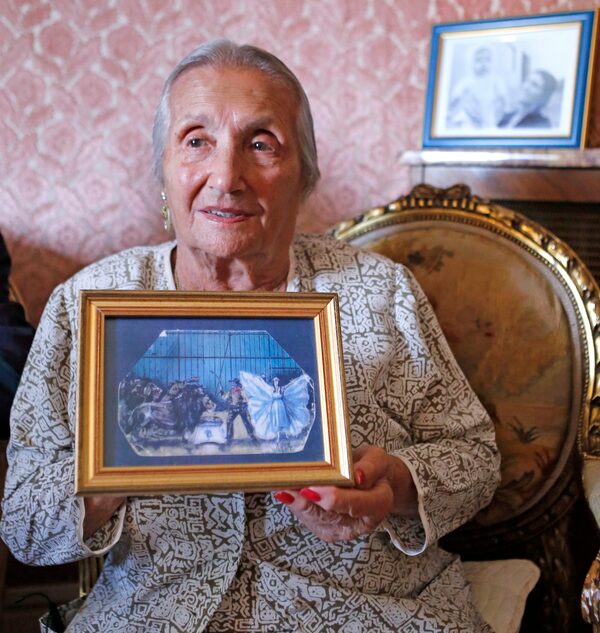
Rosa van Been shows an art piece depicting her and her husband during their circus days, in her Paris apartment, Sept. 8, 2014.Jacques Brinon/AP
Rosa van Been got married behind bars when she was 17. She had chosen the venue voluntarily and was unfazed that her hirsute guests were more likely to snarl at the happy couple than smile approvingly.
After all, Rosa had grown accustomed to performing her signature serpentine dance inside the lions’ cage. Moreover, her fiancé, Joseph Bouglione, an animal trainer, also had confidence the guests wouldn’t gnaw on the happy couple. (Just to play it safe, the priest at the wedding presided from outside the cage.)
Nine decades later, Ms. Bouglione, the matriarch of the family that still operates the fabled 19th-century one-ring Cirque d’Hiver, died on Aug. 26 in her home in Paris, around the corner from the circus’s circular 2,000-seat arena, which was commissioned by Napoleon III. She was 107.
In announcing her death, the Bouglione family, which has owned the company since 1934, described her as “the undisputed queen of the circus world.”
Madame Rosa, as she was known to millions of circus aficionados for generations, was born into a travelling Roma, or Gypsy, circus family, and never outgrew the wonderment at the big top that beguiles children of all ages.
Among her pets was a foulmouthed parrot, Coco, who lived to the age of 45 and was fluent in French obscenities. She memorialized her dead pet leopard Mickey by converting him into a dining-room table throw, gnashing teeth included. She smuggled a baby gorilla into a hotel in a hat box and roomed with him for a month. Cases of Perrier water had to be stocked for Jackie, another great ape, who refused to drink anything else.
Among the guest celebrities who appeared with the circus at its famed arena and in occasional shows under the Eiffel Tower along with the acrobats, contortionists, jugglers and animal acts were Josephine Baker, Ingrid Bergman, Maurice Chevalier, Marlene Dietrich, Rita Hayworth and Jerry Lewis.
Maria Callas was nearly stomped by an elephant who was said to become agitated when Mr. Bouglione was around women other than his wife.
Rosalie van Been was born on Dec. 21, 1910, in Ixelles, Belgium, a suburb of Brussels, in a horse-drawn circus caravan. Her father, Jules, was an animal trainer. Her mother was Gina Penetenti.
“I was born in a caravan, and that’s where I left my heart,” she said in her 2011 autobiography, A Wedding in the Lions’ Cage: The Great Saga of the Bouglione Circus, which she wrote with Patrick Hourdequin.
She began performing with a circus called Ménagerie Van Been Frères at 14, interpreting a Serbian dance choreographed by U.S. actress and dancer Loie Fuller (including a pride of prowling lions directed by her father). She also introduced an act that starred a Siberian white wolf, with a supporting troupe of dogs.
In 1928, she married Mr. Bouglione, a third-generation lion tamer who, with his father and three brothers, had been performing in a version of Buffalo Bill’s Wild West Show.
They had seven children. Mr. Bouglione died in 1987. The family said that Ms. Bouglione leaves a total of 55 children, grandchildren, great-grandchildren and great-great-grandchildren.
In 1935, the Bougliones began touring with the Cirque d’Hiver, which they had rescued from bankruptcy the year before.
During the Second World War, the company was permitted to operate despite Nazi occupation, concealing the couple’s Romany roots behind the Bouglione family’s Italian-sounding name. They protected Jewish performers and secreted weapons for the French resistance.
As the years went on, Ms. Bouglione moved from performing at the circus to managing it.
The September, 1955, issue of Harper’s Bazaar included a photograph by Richard Avedon of fashion model Dovima at the circus, flanked by two elephants. A print is in the collection of the Victoria and Albert Museum in London.
Burt Lancaster, Tony Curtis and Gina Lollobrigida filmed Carol Reed’s 1956 love-triangle movie Trapeze at the Cirque d’Hiver (where the flying trapeze was said to have been introduced). That was when, according to an account in The New York Times, Mr. Bouglione told Mr. Lancaster he could “practically guarantee” his safety during a scene with a tamed lion.
“If by ‘practically’ you mean no more than the loss of an arm,” Mr. Lancaster, a former circus acrobat himself, replied, “then it’s a deal.”
Ms. Bouglione never lost her love of the circus, even as she matured into the family’s doyenne.
“The shows got bigger and the children got bigger,” she once said, “but I got smaller.”
Her concessions to growing older were to move closer to the circus in 1984 and to attend matinees instead of evening performances. But she remained as candid as ever in communicating her opinions to the performers.
By the turn of the 21st century, the Cirque d’Hiver’s shows were getting smaller, too; the venue was playing host to concerts, musicals and political rallies; and the company was being pressured by animal-rights groups – unsuccessfully so far – to eliminate non-human performers. (To which Ms. Bouglione’s son Joseph-Eugene replied, “The circus without animals is a meal without wine.”)
Still, Ms. Bouglione remained hopeful that the show would endure forever.
“As long as there are children,” she said, “there will be circus.”